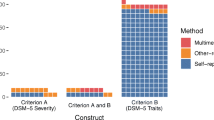Abstract
This study assessed the validity of the DSM-III-R personality disorder clusters (i.e., odd-eccentric, dramatic-emotional-erratic, and anxious-fearful) by examining the relationships between self-report measures that tap the “core” features shared by disorders from each cluster and Cluster scores established via a semistructured interview in a sample of 57 outpatients. Results indicated a high degree of correlation among the DSM-III-R personality disorder Cluster scores. In addition, a series of regression analyses revealed that self-report scores did not account for a significant amount of variance in their respective Cluster scores over and above that accounted for by other self-report measures and other Cluster scores. These results suggest that the current DSM-III-R cluster classification scheme may not be appropriate, and it is recommended that a more empirically justifiable classification of the personality disorders be adopted in DSM-IV.
Similar content being viewed by others
References
American Psychiatric Association (1987).Diagnostic and statistical manual of mental disorders, (3rd ed., rev.). Washington, DC: American Psychiatric Association.
Costa, P. T., Jr., & McCrae, R. R. (1985).The NEO Personality Inventory: Manual. Odessa, FL: Psychological Assessment Resources.
Costa, P. T., Jr., & McCrae, R. R. (1990). Personality disorders and the five-factor model of personality.Journal of Personality Disorders, 4, 362–371.
Fabrega, H., Ulrich, R., Pilkonis, P., & Mezzich, J. (1991). On the homogeneity of personality disorder clusters.Comprehensive Psychiatry, 32, 373–386.
Graham, J. R. (1990).MMPI-2: Assessing personality and psychopathology. New York: Oxford University Press.
Hathaway, S. R., & McKinley, J. C. (1989), with the MMPI Restandardization Committee appointed by the University of Minnesota Press, Butcher, J. N., Dahlstrom, W. G., Graham, J. R., Tellegen, A., & Kaemmer, B.,Minnesota Multiphasic Personality Inventory-2: Manual for administration and scoring. Minneapolis: University of Minnesota Press.
Hyler, S. E., & Lyons, M. (1988). Factor analysis of the DSM-III personality disorder clusters: A replication.Comprehensive Psychiatry, 29, 304–308.
Hyler, S. E., Lyons, M., Rieder, R. O., Young, L., Williams, J. B. W., & Spitzer, R. L. (1990). The factor structure of self-report DSM-III Axis II symptoms and their relationship to clinicians' ratings.American Journal of Psychiatry, 147, 751–757.
Kass, F., Skodol, A. E., Charles, E., Spitzer, R. L., & Williams, J. B. (1985). Scaled ratings of DSM-III personality disorders.American Journal of Psychiatry, 142, 627–630.
Kernberg, O. (1984).Severe personality disorders: Psychotherapeutic strategies. New Haven, CT: Yale University Press.
Millon, T. (1981).Disorders of Personality, DSM-III, Axis II. New York, Wiley.
Morey, L. C. (1988). The categorical representation of personality disorder: A cluster analysis of DSM-III-R personality features.Journal of Abnormal Psychology, 97, 314–321.
Morey, L. C., & Smith, M. R. (1988). Personality disorders. In R. L. Greene (Ed.),The MMPI: Use with specific populations. Philadelphia: Grune & Stratton.
Pfohl, B., Blum, N., Zimmerman, M., & Stangl, D. (1989).Structured Interview for DSM-III-R Personality (SIDP-R). University of Iowa College of Medicine.
Reich, J. H. (1989). Familiarity of DSM-III dramatic and anxious personality clusters.The Journal of Nervous and Mental Disease, 177, 96–100.
Reich, J., & Thompson, W. D. (1987). DSM-III personality disorder clusters in three populations.British Journal of Psychiatry, 150, 471–475.
Shea, M. T., Glass, D. R., Pilkonis, P. A., Watkins, J., & Docherty, J. P. (1987). Frequency and implications of personality disorder in a sample of depressed outpatients.Journal of Personality Disorders, 1, 27–42.
Shrout, P. E., & Fleiss, J. L. (1979). Intraclass correlations: Uses in assessing rater reliability.Psychological Bulletin, 86, 420–428.
Skodol, A. E. (1989).Problems in differential diagnosis: From DSM-III to DSM-III-R in clinical practice. Washington, DC: American Psychiatric Press.
Task Force on DSM-IV, American Psychiatric Association (1991).DSM-IV options book: Work in progress (7/1/91). Washington, DC: Author.
Trull, T. J. (1992). DSM-III-R personality disorders and the five-factor model of personality: An empirical comparison.Journal of Abnormal Psychology, 101, 553–560.
Widiger, T. A., Trull, T. J., Hurt, S. W., Clarkin, J., & Frances, A. (1987). A multidimensional scaling of the DSM-III personality disorders.Archives of General Psychiatry, 44, 557–563.
Widiger, T. A., Frances, A. J., Harris, M., Jacobsberg, L. B., Fyer, M., & Manning, D. (1991). Comorbidity among axis II disorders. In J. M. Oldham (Ed.),Personality disorders: New perspectives on diagnostic validity (pp. 165–194). Washington, DC: American Psychiatric Press.
Wiggins, J. S., & Pincus, A. L. (1989). Conceptions of personality disorders and dimensions of personality.Psychological Assessment, 1, 305–316.
Zimmerman, M., & Coryell, W. (1989). DSM-III personality disorder diagnoses in a nonpatient sample.Archives of General Psychiatry, 46, 682–689.
Author information
Authors and Affiliations
Rights and permissions
About this article
Cite this article
Schopp, L.H., Trull, T.J. Validity of the DSM-III-R personality disorder Clusters. J Psychopathol Behav Assess 15, 219–237 (1993). https://doi.org/10.1007/BF01371380
Accepted:
Issue Date:
DOI: https://doi.org/10.1007/BF01371380



